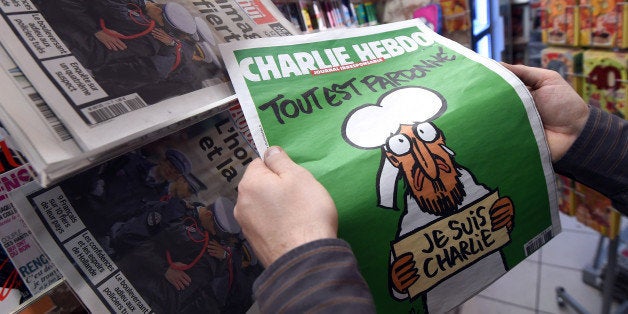
A green background, a sign, and a tear. The Jan. 14 edition of the French satirical newspaper Charlie Hebdo, published less than a week after the brutal attack against the newspaper's offices, shows on its cover a cartoon representing the Prophet Muhammad with the line “all is forgiven.” It was sold out in record time. With more than five million copies printed, a first for the French press, it was also in high demand abroad.
But Charlie Hebdo's “survivor issue,” as it has been nicknamed, hasn't received unanimous praise. Indeed, political parties in countries like Jordan, religious institutions such as Al-Azhar in Egypt and even religious figures like the mufti of Jerusalem have criticized the front page image, asserting that it hurts the feelings of Muslims. In Turkey, a court even banned website pages that showed the cover.
This week's front page is a lot less defiant, if it is defiant at all, when compared to the caricatures previously published by the satirical newspaper. So how can these reactions be explained? HuffPost asked religious anthropologist and psychoanalyst Malek Chebel, author of the book "L'Inconscient De L'Islam" (The Unconscious of Islam).
A Political Position
According to Chebel, the criticism of Charlie Hebdo's new cover is not surprising, given the newspaper’s past.
"Charlie Hebdo does not have a good image within the Muslim world since it published its caricatures of the prophet. Some undoubtedly still have a negative image of the paper in mind,” Chebel told HuffPost. “I think certain people must have been thrown off balance by this front page, they must have been waiting for something more ‘savage’, more divisive than that."
“To my mind, it’s more of a political, ideological position, rather than a doctrinal question or an opinion,” Chebel continued. "Because from a religious perspective, there is no reason to be indignant about this front page. Indeed, no passage of the Quran forbids the representation of a living being and therefore of the Prophet Muhammad."
The Pervasiveness Of Images
It's important to look at the hadiths, a group of texts that retell the actions and words of the prophet, to understand the argument that Muhammad should not be depicted. What is condemned in these texts is idolatry, a serious sin in Judaism, Christianity and Islam. Chebel says that these hadiths are open to interpretation and in his opinion do not forbid the creation of images in and of itself. If certain theological schools of thought have condemned the creation of images, specifically to avoid idolatry and because God is the sole creator, others have a more conciliatory reading. The researcher points at illustrations in books or on miniatures, such as in Iran or in the Shiite regions.
For Malek Chebel, the question of representation is a central one today.
“We bask in images. Inevitably, this presence is going to have its word to say, to impose itself on us. And this pervasiveness of the image will leave no grey area. I don’t see how Muslims will escape the image’s reign,” he says, adding, “It’s one of the issues of tomorrow. And I think in the end the criticism of images will little by little become about blasphemy itself, offensive to the Prophet, rather than the shape in which it comes.”
This piece originally appeared in HuffPost France and was translated into English.